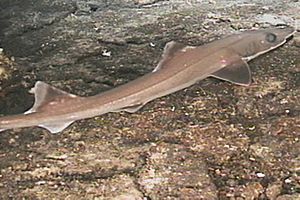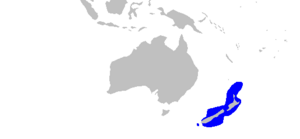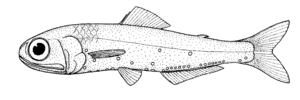Slender smooth-hound facts for kids
Quick facts for kids Slender smooth-hound |
|
|---|---|
 |
|
| Conservation status | |
| Scientific classification | |
| Genus: |
Gollum
|
| Species: |
attenuatus
|
 |
|
| Range of the slender smooth-hound | |
| Synonyms | |
|
Triakis attenuata Garrick, 1954 |
|
The slender smooth-hound or gollumshark (Gollum attenuatus) is a type of ground shark. It belongs to the family called Pseudotriakidae. This shark lives only in the waters around New Zealand. You can usually find it near the bottom of the continental slope, which is the edge of the continent underwater. It lives at depths of about 300 to 600 meters (980 to 2,000 ft).
This shark is very thin and can grow up to 1.1 meters (3.6 ft) long. It has a plain brownish color. You can recognize the slender smooth-hound by its wide, flat head and a long snout shaped like a bell. Its mouth is angled, with small grooves at the corners. It has many rows of tiny teeth in both its upper and lower jaws. Both of its dorsal fins (the fins on its back) are about the same size.
The slender smooth-hound eats many different things. It mostly eats small bottom-dwelling bony fish and decapod crustaceans like crabs or shrimp. This shark has a special way of having babies. The female shark produces a single capsule in each of her two uteruses. Inside each capsule are 30 to 80 eggs. Only one egg grows into a baby shark. This baby shark eats the other eggs and stores the yolk in a special sac outside its body. This yolk sac helps the baby grow. Usually, two baby sharks are born at a time, one from each uterus. The IUCN says this shark is "Least Concern." This means it is not in danger right now. Fishermen sometimes catch it by accident, but not very often. Also, many parts of its home range are not fished much.
Contents
About the Slender Smooth-Hound
Naming the Gollumshark
The first known slender smooth-hound was a 93 cm (37 in) long male shark. It was caught by a trawler called Maimai in December 1953. This happened off Cape Palliser on New Zealand's North Island, about 220 meters (720 ft) deep. The crew kept it because it was unusual. They gave it to a fish expert named Jack Garrick.
In 1954, Garrick described the shark in a science magazine. He named it Triakis attenuata. The word "attenuate" means very slender, which describes the shark's body. Later, in 1973, another scientist named Leonard Compagno suggested a new name for this shark: Gollum. He named it after the character from J. R. R. Tolkien's The Lord of the Rings. Compagno thought the shark looked and acted a bit like Gollum.
Scientists now group Gollum and another shark called the false catshark together in the family Pseudotriakidae. Studies have shown that these two types of sharks are very similar genetically. This means they are closely related. There is also another type of Gollum shark that has been found, and possibly more to discover!
Where the Gollumshark Lives
The slender smooth-hound lives only around New Zealand. This includes underwater areas to the north, like the Three Kings Ridge and the Challenger Plateau. This shark is not very common. It mostly lives between 300 and 600 meters (980 and 2,000 ft) deep. However, it has been found as deep as 724 meters (2,375 ft).
It likes water that is around 10°C (50°F) and has a saltiness of about 34.8 parts per thousand. This shark usually swims near the sea floor. It lives in places with both soft sand and rocky bottoms. It can be found in flat areas or on steep underwater slopes.
What the Gollumshark Looks Like
The slender smooth-hound has a very thin body and a wide, flat head. Its snout is long and looks like a bell when you see it from above. Its eyes are long and oval-shaped. They have small, protective third eyelids. Below each eye is a noticeable ridge, and behind it is a tiny hole called a spiracle. Its nostrils have small, triangle-shaped skin flaps in front of them.
The shark's mouth is angled, with very short grooves at the corners. It has many rows of small, tightly packed teeth. Each tooth has a narrow point in the middle and smaller points on each side. It has five pairs of short gill slits.
The pectoral fins (side fins) start below the fourth gill slit. They have gently curved edges. The pelvic fins (lower fins) are small and angled. Male sharks have pointed claspers. The two dorsal fins (back fins) are similar in size and shape. They have rounded tips and curved back edges. The first dorsal fin is above the back part of the pectoral fins. The second dorsal fin is between the pelvic and anal fins. There is a ridge along its back between the dorsal fins. The anal fin is less than half as tall as the first dorsal fin.
The caudal fin (tail fin) is short and narrow, making up about one-sixth of the shark's total length. The lower part of the tail fin is not very clear. The upper part has a strong notch near the tip. The shark's skin is covered with many small, overlapping dermal denticles, which are like tiny scales. Each denticle has a crown on a short stalk. This crown has three ridges that lead to blade-like teeth, with the middle tooth being the longest.
This shark is plain brownish-gray on top and lighter underneath. It can grow up to 1.1 meters (3.6 ft) long and weigh up to 4 kg (8.8 lb). Female sharks usually grow a little larger than males.
Life and Habits
What the Gollumshark Eats

The slender smooth-hound probably lives in groups or schools. It eats many different bottom-dwelling fish and invertebrates (animals without backbones). It also acts as a scavenger, meaning it eats dead things. People have even found human garbage in its stomach!
Small bony fish, especially lanternfishes, are its favorite food. After that, it likes decapod crustaceans. It might also eat Cephalopods (like squid), snails, isopods, brittle stars, small dogfish sharks, and cartilaginous fish egg capsules. Young sharks under 50 cm (20 in) long especially like to eat cephalopods.
Reproduction and Life Cycle
Like the false catshark, the slender smooth-hound has a special way of giving birth called aplacental viviparity with oophagy. This is different from how some other sharks, like mackerel sharks, reproduce. Female slender smooth-hounds have one working ovary (on the right side) and two working uteruses.
Only one baby shark develops in each uterus at a time. This means a female usually gives birth to two pups, though sometimes only one. The inside of the uterus has tiny finger-like bumps called villi. Inside each uterus, there are 30 to 80 eggs, each about 4 to 8 mm (0.16 to 0.31 in) across. Only one egg gets fertilized and grows into a baby shark. The other eggs break down.
The baby shark eats these other eggs and moves the yolk material into a special sac outside its body. This external yolk sac is its main food source while it grows inside the mother. This eating of other eggs happens when the baby shark is very small, about 10 to 39 mm (0.39 to 1.54 in) long. The baby shark might also get extra food from a special "uterine milk" produced by the mother.
When the baby shark is about 29 to 40 mm (1.1 to 1.6 in) long, it comes out of the egg capsule. By this time, the capsule has become clear and jelly-like. Baby sharks that are 4 to 25 cm (1.6 to 9.8 in) long have well-developed external gill filaments. The external yolk sac is completely gone when the baby shark is about 34 to 42 cm (13 to 17 in) long, which is close to when it is born. Both male and female sharks become able to have babies when they are about 70 cm (28 in) long.
Gollumshark and Humans
The slender smooth-hound is not harmful to humans and is not caught for food. However, it is sometimes caught by accident in bottom trawl nets or on bottom longlines. Many parts of its northern home range are not fished very much. Because of this, the IUCN has listed it as "Least Concern," meaning it is not currently in danger.
However, this shark does not have many babies. This means that if fishing increased a lot in the future, its population could decrease. In June 2018, the New Zealand Department of Conservation said the slender smooth-hound is "Not Threatened." They added the note "Secure Overseas," meaning it's doing well in other places too.
See also
 In Spanish: Gollum attenuatus para niños
In Spanish: Gollum attenuatus para niños



